yoshinobu nakagawa, "stalk"jan. 28 - mar. 11, 2006taguchi fine art, ltd. |
|
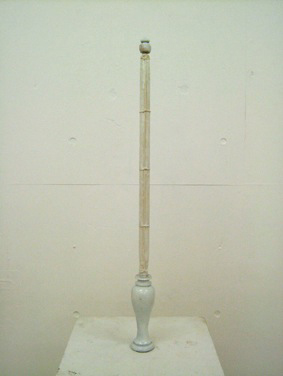
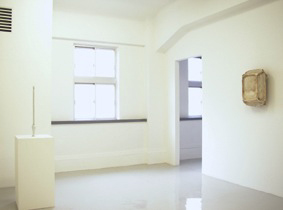
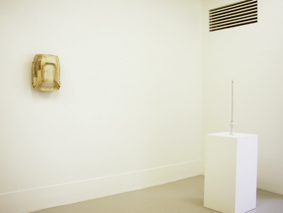
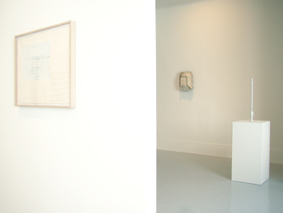
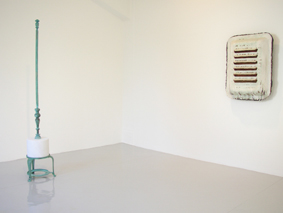
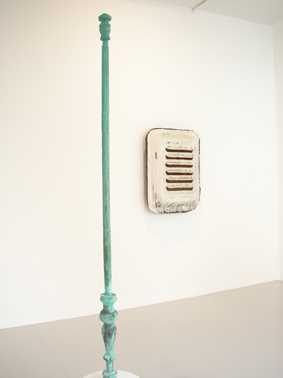
|
Born in Osaka in 1964, Yoshinobu Nakagawa now resides in Shiga prefecture. Ever since his first one-person show in 1987, the year he graduated from Osaka University of Art, Nakagawa's motif has been consistently plants or relationship between plants (nature) and mankind (farmer), or agriculture and cultivation, which is fundamental work to us. His artisanship, which freely controls every kind of materials and the poetic emotions, when looking at the naive form of his work, attracts many people. This is his third show at taguchi fine art, ltd. after an interval of three years. sculpture and baseAt his last show "on the table", Nakagawa examined the relationship between base and sculpture, which is an important issue for art history or aesthetics. His point of view was very unique as he considered it on the analogy of the relationship between ridges in the field and the farm products, as cabbages or Chinese cabbages on them. He kept this idea for a long time and finally his effort resulted in the work called "on the table" - a work with three white cast plaster polyhedra on a table made of wood and cast bronze. The piece succeeded in reminding the viewer of strange scenery of a farm field.Nakagawa developed this idea on the occasion of his show at Nomart Edition in Osaka, making a installation with a large number of tables with polyhedra on them. He created a marvelous landscape of a farm village in an urban gallery space. With that installation he found his own answer and settled his research on this theme. Since then he ceased to show his new pieces to the public and kept silence for more than two years. germination and extinctionNakagawa became to have less interest in the issues of art history or aesthetics and his concern has returned to the landscape and people's lives in a village at a mountain side where he lives.His observation of farmer's work, which has been kept without a break from ancient times, lead him to consider about the cycle of nature and life, germination and extinction. According to his recent interest, Nakagawa took, as motifs for his new works, the "place" where farmer grows plants, and the "flower stalk" which Nakagawa regards as the last glitter of plants just before their extinction. Farmer creates ridges in the field as the cradle for plants and chooses certain points to sow plant seeds as the privileged place. Flower stalk is originally the stem of flower. In case of farm plants, it means the stem which grows too long and too stiff. It also symbolizes the situation that the best time to eat the plant has passed. In this flower stalk, left behind the productive activity by farmer, Nakagawa sees brightness of life, cycle of nature, and also thoughtfulness of farmer. Transition from "point to seat (point to be sown)" to "flower stalk" makes me aware of a fundamental things rather than the issue of the relationship between sculpture and base. That is the cycle of life, from germination to extinction. "Flower stalk" might be the glitter of life just before the plant dies. With a sharp, observant eye, our predecessors have created ridges on the earth and found suitable points to sow, to make plants sit and grow there with every effort. The harvest time comes and farmers gather their crops, usually one or two to be left. I remember these ignored flower stalks become landmarks on the ridges. I always wondered very much why a few should be left. One morning, looking those landmarks on the ridges covered with snow, I found a probable answer to see birds pecking them. There are lives kept with such a modest share from our predecessors. In spring those landmarks get longer and then present different scenery. They become things grown with no aim, no sense to farmers. I like this aimlessness more than anything else. Yoshinobu Nakagawa checklist of the installation 1. Stalk #1, 2004 wood, canvas, string, color 59.8 x 5.0 x 5.0 cm 2. Point to Seat #4, 2006 reclaimed paper, cowhide, wood, cotton, acrylic and string 37.0 x 17.5 x 30.0 cm 3. Point to Seat #1, 2006 reclaimed paper, cowhide, wood, cotton, acrylic and string 50.0 x 20.0 x 40.0 cm 4. Stalk #2, 2006 bronze, marble 179.0 x 31.0 x 35.0 cm 5. Ridges on the Table, 1992 reclaimed paper, acrylic, color, metalic powder, cowhide, beeswax and string 80.0 x 21.5 x 62.0 cm 6. Garden of Mirrors #3, 2006 acrylic on paper 50.0 x 65.0 cm |